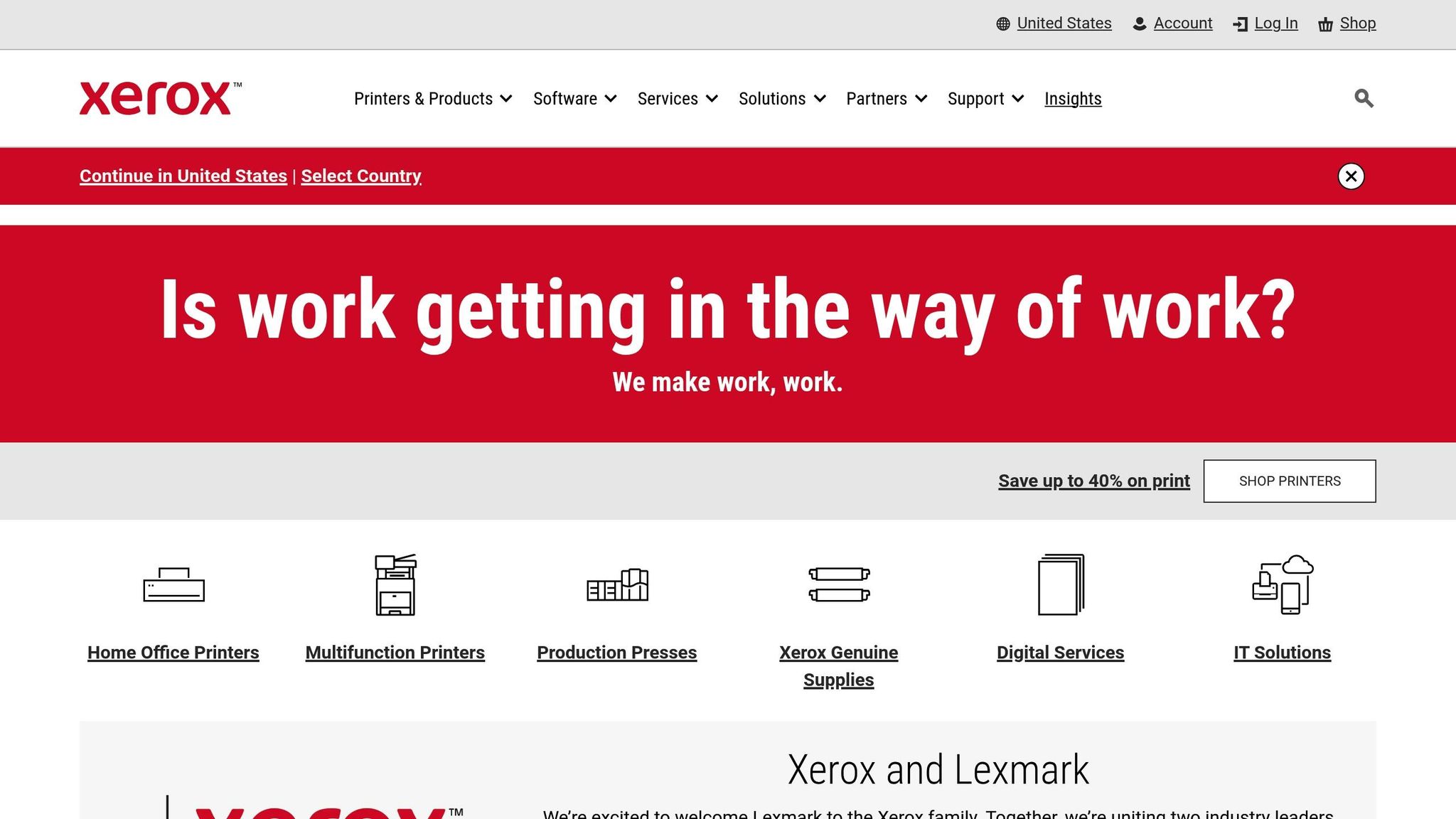Automation is transforming how small and medium-sized businesses (SMBs) operate by simplifying repetitive tasks, reducing errors, and saving time. Here are the key takeaways:
- What is Workflow Automation? It uses technology to handle tasks like data entry, invoicing, and email follow-ups, freeing employees for more meaningful work.
- Why It Matters: SMBs face tight competition and limited resources. Automation helps cut costs, improve accuracy, and boost productivity.
- Adoption Trends: 76% of SMBs are using or exploring AI, with 91% reporting revenue growth from automation tools.
- Key Benefits: Businesses save time, reduce errors, and improve customer satisfaction through tools like chatbots, CRM integrations, and automated reporting.
- Best Practices: Start small with repetitive tasks, map out processes, and choose user-friendly tools that integrate with your systems.
Automation isn't just a tool - it's becoming a necessity for SMBs to stay competitive, cut inefficiencies, and focus on growth.
In the Spotlight with Xerox - Driving SMB Automation Success

Key Benefits of Workflow Automation
Automation has become a game-changer for small and medium-sized businesses (SMBs), reshaping how they operate and compete. By integrating automation into their workflows, SMBs can unlock efficiency, reduce costs, and enhance customer satisfaction.
Increased Productivity Through Task Automation
Did you know entrepreneurs spend up to 16 hours a week on repetitive tasks? That’s a lot of valuable time tied up in routine work. Automation changes the game here - over 90% of employees report higher productivity, and 85% say it improves team collaboration. By automating these mundane tasks, employees can shift their focus to more impactful activities like strategic planning, building customer relationships, and solving complex problems creatively.
Whether it’s automating email responses or streamlining data entry, scalable tools can take care of repetitive work, freeing up time for what truly matters.
Lower Costs and Fewer Errors
Automation doesn’t just save time; it saves money too. Businesses that adopt automation see impressive returns - some report an average ROI of 240% within months of implementation. In areas like logistics, manufacturing, and office administration, automation can slash operational costs by up to 90%.
Manual processes, which SMBs spend over 15 hours a week on, are not only time-consuming but also prone to costly errors. Automated systems minimize these mistakes, ensuring smoother workflows and better resource allocation. For example, a small online retailer integrated Shopify with tools like OrderlyEmails and Stock Sync, cutting manual tasks by 70% and speeding up order processing by 50%. Similarly, a manufacturer using Odoo’s ERP system reduced inventory costs by 40% and boosted production efficiency by 25%.
Automation also shines in areas like accounting and inventory management, where accuracy is critical. Self-service payment systems, for instance, reduce errors caused by miscommunication or incorrect data entry. With 89% of financial executives citing losses due to inefficient payment processing, automation ensures smoother, more reliable outcomes - enhancing both efficiency and customer experience.
Better Customer Satisfaction
Happy customers are loyal customers, and automation helps businesses deliver the kind of service that keeps them coming back. Tools like chatbots and CRM integrations allow businesses to respond to inquiries quickly and personalize interactions using data insights. This leads to faster response times and more consistent service delivery, ensuring customers feel valued.
For instance, a digital marketing agency used tools like Hootsuite and Google Analytics to automate client reporting and social media management, boosting client retention by 30%.
"By taking repetitive tasks off your plate, automation lets you focus on growing your business and building real connections with your clients."
– Kathryn Schwab, founder of Make It Count Creative Solutions LLC
"This kind of emotional intelligence helps businesses respond faster and more empathetically, making customers feel heard and valued while still benefiting from automation's efficiency."
– Kathryn Schwab, founder of Make It Count Creative Solutions LLC
Automated customer support systems, like ticket management and email updates, ensure customers are informed every step of the way. With 24/7 support options, customers know they can rely on your business whenever they need help. The result? Happier customers and stronger relationships that fuel long-term success. These benefits set the stage for the real-world examples highlighted in the next section.
Research Data on Automation in SMBs
Recent studies highlight how automation is reshaping the way small and medium-sized businesses (SMBs) operate across the United States. These findings show that automation not only improves efficiency but also helps SMBs tackle market challenges more effectively.
Automation Adoption Rates and Trends
Automation is making significant inroads among U.S. SMBs. Around 38% of SMBs in the country are actively leveraging AI for tasks like recruitment, customer support, and campaign management. Globally, the numbers are even more striking - 77% of small businesses have adopted AI tools in at least one area, and 75% are experimenting with AI. Among growing businesses, this figure rises to 83%.
The integration of automation tools spans various workflows, with marketing being a standout area. About 69% of small business owners frequently use AI for marketing tasks, and 17% rely on it daily or weekly.
In 2024, data from Statista revealed that 58% of marketing decision-makers automated email campaigns, 49% automated social media, and 33% streamlined content management through automation. HR automation has also experienced a dramatic surge, with a staggering 599% increase in adoption in recent years, driven by the need to simplify people management processes.
These adoption trends are matched by tangible improvements in efficiency and productivity.
Measured Efficiency Gains
The impact of automation on productivity is hard to ignore. Around 74% of employees report faster work performance thanks to automation, and 88% trust these tools for their accuracy and reliability.
Specific departments see notable benefits. For instance, payment automation helps finance teams reclaim over 500 hours annually, with up to 80% of transactional tasks now automated. In sales, automation allows 82% of teams to dedicate more time to building stronger client relationships.
Automation also enhances employee satisfaction. A remarkable 88% of workers report higher job satisfaction, while 84% feel it improves overall company morale. Additionally, 65% of knowledge workers experience reduced stress from automating manual tasks, and 90% believe it has improved their work lives.
For SMBs, the numbers are equally compelling. Automation can boost productivity by up to 30%, cut manual errors by 25%, and improve data accuracy, enabling employees to focus on strategic initiatives. In certain industries, initial automation efforts have led to production increases of up to 5.1%.
Marketing automation, in particular, delivers strong results. Small businesses using these tools report a 25% increase in marketing ROI, a 451% jump in qualified leads, and 70.5% higher email open rates. Time savings are another win: 73% of IT leaders say automation reduces task time by about 50%, and businesses save over 6 hours weekly by automating social media content and ads. For example, the payment processing firm iPSL cut the time needed for budgets and forecast reports by 66%, reducing a six-week process to just 10 days using an automated Excel interface.
Finally, automation levels the playing field for SMBs, with 88% of small business owners stating it helps them compete more effectively with larger companies. These numbers make it clear: automation is no longer a luxury - it’s become a vital part of staying competitive in today’s business landscape.
Case Studies: Automation in Action
These examples show how companies in different industries are using automation to cut costs and improve efficiency. From retail to professional services, automation is changing how businesses operate, offering practical solutions to real-world challenges.
E-Commerce: Automated Order Processing
E-commerce businesses often struggle with managing large volumes of orders while keeping errors to a minimum. A global footwear retailer provides a great example of how automation can solve this issue. By automating 98% of their order processes, they saved thousands of hours.
Their system handled everything from order management and inventory tracking to shipping and returns. It confirmed purchases, updated stock, generated invoices and shipping labels, and even processed returns - all automatically. This was a game-changer, especially since nearly two-thirds of fulfillment or inventory issues are caused by human errors. The automation eliminated mistakes like incorrect shipping addresses and duplicate orders, speeding up fulfillment and improving accuracy.
The financial benefits were impressive. Automation in e-commerce can boost ROI by up to 45%, and this retailer saw similar results. By centralizing order data across multiple platforms, they reduced errors like overselling and stockouts.
"Order processing automation is no longer just for enterprise-level businesses. Today's technology makes it possible for businesses of all sizes to implement powerful automation solutions that eliminate repetitive tasks, reduce errors, and scale operations without expanding their teams."
This case highlights why automation is crucial for e-commerce SMBs. With retailers losing an estimated $1.8 trillion to inventory issues in 2023, automated systems are more than helpful - they’re essential for avoiding costly mistakes and supporting growth.
Marketing Agencies: Automated Campaign Management
Marketing agencies handle a constant flow of clients, campaigns, and deadlines, making automation a valuable tool. Take Pit Boss Grills, for example. Using ActiveCampaign’s automation, they generated $76,717 from just two emails by streamlining forms, tagging, and workflows.
Their success came from adopting a system that automated repetitive tasks across different marketing channels. It integrated CRM data, email marketing, and analytics, creating a smooth flow of information and automating customer journeys.
MSI Chicago, another ActiveCampaign user, praised the platform’s versatility:
"ActiveCampaign lets us send email campaigns, automate features, and manage contacts by staff group. The holy trinity. Other tools couldn't do all three."
The impact of marketing automation is clear. Companies using such tools often see a 34% increase in revenue and a 14% boost in sales productivity. Modern platforms now offer AI-driven features that simplify the process even further. For instance, ActiveCampaign's AI automation builder lets users describe workflows via a chatbot, which then sets up the automation. Additionally, 79% of businesses have partially automated customer journeys, and lead nurturing automation can increase sales opportunities by 20% compared to non-automated approaches.
Professional Services: Automated Project Management
Automation isn’t just for retail and marketing - it’s also transforming professional services by improving project management. Firms in this sector face challenges like tracking billable hours, managing client communications, and meeting deadlines. Humanity Communications Collective offers a great example of how automation can help.
CEO Yanira M. Castro introduced robust automation systems to address communication bottlenecks and improve client response times. This allowed her team to quickly access information and respond more effectively to client needs.
"Implementing robust communication and tracking systems eliminated wasted time and boosted responsiveness. It also allowed us to become more responsive to clients, which leads to better quality work."
Splurge Media took a similar approach. By automating pricing and project management workflows, they standardized their processes. Founder and CEO Rodrigo Campos explained:
"Once we understand our processes, workflows, and staffing needs for every project and initiative, we price our services with profitability."
These examples show how automation in professional services can streamline operations, improve communication, and allow firms to focus on delivering exceptional client work.
sbb-itb-a3ef7c1
Best Practices for SMB Automation Implementation
Rolling out automation successfully takes a well-thought-out approach. The goal is to minimize risks while reaping the benefits, and that starts with careful planning, selecting the right tools, and scaling up gradually to meet your business’s specific needs.
Finding the Right Processes to Automate
Not every task in your business is a good fit for automation. SMBs should focus on repetitive, time-consuming activities that follow clear, predictable rules. Common examples include data entry, transferring information between systems, or routine administrative tasks that don’t require human judgment.
The first step? Map out your processes. Break each one down step by step, identify how systems interact, and trace the flow of data. This exercise helps pinpoint bottlenecks and reveals which processes could benefit most from automation.
Next, prioritize tasks based on their potential impact and how easy they are to automate. Focus on activities that align directly with your business goals - whether that’s cutting costs, improving customer service, or supporting growth. Automating repetitive processes often yields the biggest efficiency boosts. To set yourself up for success, create clear standard operating procedures (SOPs) for each process. These SOPs will be invaluable when configuring automation tools and training your team.
Start small, with simple automations, and build on that foundation as you gain experience.
Start Small and Scale Up
Begin with low-risk, repetitive tasks that can deliver quick wins without disrupting your operations. Tasks like sending reminders, generating basic reports, or transferring data are great starting points. They’re easy to automate and can quickly show value while building confidence in the process.
Take DEONET, a small promotional products manufacturer, as an example. They introduced an ABB YuMi collaborative robot (cobot) into their assembly line to handle small-batch production tasks. Automating glue application and assembly boosted their production capacity to 3,000 parts per day while maintaining quality. This step-by-step approach addressed specific labor challenges without overwhelming their operations.
Test your initial automations thoroughly, monitor for any issues, and tweak as needed before scaling up. Another example is AA Precision Tooling, which partnered with Acieta to implement a robotic machining cell. The result? A 60% increase in output, reduced scrap, and new customer acquisition. Once you’ve mastered simpler tasks, you can gradually move on to more complex areas like AI-powered resource management or customer journey automation.
Choose Simple, Proven Tools
After testing on a small scale, selecting tools that align with your growing needs becomes crucial. With 75% of small businesses now leveraging AI tools for tasks like financial management, email marketing, and security, there’s no shortage of options. But simplicity and dependability should guide your choice.
| Feature | Why It Matters | Key Features |
|---|---|---|
| Ease of Use | Ideal for small teams with limited expertise | User-friendly interface, drag-and-drop functionality |
| Integration | Ensures smooth data flow between systems | Compatibility with tools like CRM or accounting software |
| Scalability | Grows alongside your business needs | Flexible pricing plans, expandable features |
| Cost | Balances functionality with budget | Free trials, tiered pricing options |
| Customer Support | Offers help when needed most | Tutorials, live chat, detailed documentation |
Focus on automating tasks that deliver quick, noticeable time savings and involve your team in the planning process.
"Automation helps organizations to eliminate repetitive tasks and improve productivity."
– Sundram Kumar, CRM Advisor at Biztechnosys
For instance, CRM systems are known to increase customer satisfaction by 32%. Start with reliable tools that integrate seamlessly with your current systems rather than trying to tackle everything at once. Regularly review your automated processes to ensure they stay aligned with your business goals and continue to provide value.
When it comes to tools, balance functionality with simplicity. Advanced platforms may pack in a ton of features, but they can also be overly complex and expensive for small businesses. Instead, choose tools that address your immediate needs without unnecessary bells and whistles.
How Clearly Acquired Improves SMB Efficiency

Small and medium-sized businesses (SMBs) often face hurdles in acquisitions and funding that can slow down their growth. Clearly Acquired steps in with a tech-driven platform designed to simplify and automate these processes. By streamlining acquisition workflows and funding tasks, the platform helps SMBs operate more efficiently. It bridges the gap between deal sourcing and long-term business management, creating a seamless experience from start to finish.
AI-Powered Business Acquisition Tools
Acquiring a business has traditionally been a time-consuming process, filled with endless research and paperwork. Clearly Acquired changes the game with its AI-powered tools, making it easier for buyers to uncover opportunities - whether they're on the market or off. With advanced search filters based on industry, location, and deal size, users can quickly narrow down options and avoid irrelevant listings. To add an extra layer of security, the platform includes user verification systems, helping to weed out fraudulent transactions.
Another time-saver is the automated NDA feature, which handles the drafting, sending, and tracking of agreements. This allows buyers to focus on evaluating deals rather than getting bogged down in administrative tasks. The platform also centralizes the entire transaction process with tools like deal management hubs, which organize documents, communications, and key milestones. Private data rooms, enhanced with AI, offer a secure and efficient way to manage due diligence, ensuring all documents are well-organized and accessible.
Integrated Funding Solutions
Financing is often one of the biggest obstacles in SMB acquisitions, but Clearly Acquired simplifies this challenge with integrated funding solutions. Through its network of over 193 lenders, including banks, trusts, and private debt partners, the platform matches buyers with the right financing options based on their specific deal needs. This eliminates the need for extensive outreach and speeds up the funding process.
With access to a variety of financing options - such as SBA loans, SBA 7a, SBA 504, commercial loans, lines of credit, equipment financing, and more - buyers can find solutions tailored to their acquisition goals. The platform also provides expert guidance to help buyers navigate and structure deals effectively.
"Clearly Acquired's financing solutions empower buyers to overcome financial hurdles and achieve their business acquisition goals."
This one-stop approach combines lender connections, financing options, and professional advice, making the funding process smoother and more aligned with buyers' objectives.
Complete Business Lifecycle Management
Clearly Acquired doesn’t just stop at acquisitions - it supports SMBs throughout the entire business lifecycle. With tools designed to boost efficiency, the platform helps businesses maintain momentum long after the deal is closed. Dashboards offer real-time insights into deal progress and key metrics, eliminating the need for manual data tracking. Integrated messaging keeps all transaction-related discussions in one place, reducing communication gaps.
The platform also connects buyers with seasoned operators and investors, encouraging collaboration and strategic partnerships that can improve business performance post-acquisition. To help users avoid common pitfalls, Clearly Acquired provides access to a wealth of educational resources, including a business acquisition course. For those needing extra support, buy-side advisory services offer personalized guidance on sourcing, structuring, negotiating, and integrating deals.
Conclusion: The Future of SMB Efficiency with Automation
The message is clear: automation is becoming a lifeline for small and medium-sized businesses (SMBs). Recent research shows that 91% of SMBs plan to explore automation and AI services within the next year, and up to 80% believe automation is crucial for their survival.
According to McKinsey & Company, businesses that successfully adopt automation can see productivity jump by 20–35%. For SMBs, often operating with limited resources, these gains can make a world of difference. Additionally, 70% of business leaders report spending 10% to nearly 40% of their time on repetitive tasks, which means automation could free up valuable hours for more strategic priorities. These improvements don’t just streamline operations - they pave the way for long-term growth.
The benefits go beyond time savings. 79% of SMBs report measurable productivity improvements from automation, and 69% highlight enhanced business efficiency as a key outcome. Even data accuracy gets a boost, with 68% of businesses reducing errors tied to manual processes through automation.
"Automation offers a pathway to resilience, enabling SMBs to respond more swiftly to market changes, customer needs, and unexpected challenges." – Okoone
The pandemic accelerated this trend, with 75% of SMBs increasing their reliance on workflow technologies. This shift isn’t just about doing things faster - it’s about building adaptability in a business world that can change overnight. These advancements highlight the value of integrated platforms that simplify complex processes, such as acquisitions and funding.
Platforms like Clearly Acquired showcase how automation can revolutionize business transactions. By integrating AI-powered deal sourcing, automated document management, and financing tools, these platforms remove traditional bottlenecks and help SMBs navigate acquisitions with ease. This kind of automation complements operational improvements, making it easier for businesses to grow and scale efficiently.
Looking ahead, the SMBs that embrace automation thoughtfully will lead the way. Automation has the potential to save employees 240 hours and leaders 360 hours annually - a stark reminder of the cost of inaction. With 43% of SMB owners prioritizing automation, those who act now will gain a competitive edge.
The key is to start small, automating routine workflows, and then expand as confidence and expertise grow. For SMBs ready to invest in automation, the rewards are clear: higher productivity, lower costs, improved accuracy, and the resilience needed to thrive in today’s competitive landscape.
FAQs
What are the best ways for small and medium-sized businesses to identify processes suitable for automation?
Small and medium-sized businesses can spot the best candidates for automation by zeroing in on tasks that are repetitive, take up a lot of time, and follow straightforward, rule-based processes. Think data entry, invoicing, and scheduling - these are great examples where automation can boost efficiency and cut down on mistakes.
Start by evaluating tasks that require a lot of manual effort, happen regularly, or deal with large amounts of data. Focusing on processes that are standardized and consistent makes automation easier to implement. A good approach is to review workflows across the company or map out existing processes. This can help highlight areas where automation could lead to significant productivity gains and cost reductions.
What challenges do small businesses face when adopting automation, and how can they address them?
Small businesses often face hurdles when trying to implement automation. Common issues include a lack of technical know-how, pushback from employees, tight financial constraints, and trouble integrating new tools with existing systems. While these challenges may seem daunting, they can be tackled effectively with the right strategies.
To overcome these obstacles, it's important to get employees involved from the start. Early involvement helps build trust and reduces resistance. Clearly explaining how automation benefits both the business and its team can also make a big difference. Equally important is offering comprehensive training to ensure everyone feels confident using the new tools. Setting clear, measurable goals can help track progress and ensure the automation aligns with overall business objectives. Finally, choosing cost-effective and easy-to-use automation tools can simplify the transition, keeping expenses and complexity in check.
How can automation help small businesses improve customer satisfaction, and what tools are best for achieving this?
Automation allows small businesses to enhance customer satisfaction by offering quicker and more tailored support. Tools like AI-powered chatbots and automated workflows enable businesses to address customer inquiries promptly, even during off-hours. This not only keeps the interaction smooth but also fosters trust between businesses and their customers.
Key tools that make a difference include chatbots, CRM automation platforms, and no-code workflow automation tools. These technologies simplify communication, cut down response times, and provide round-the-clock support, helping small businesses offer excellent service while conserving time and resources.
































.png)







































.png)




































